I talked about how to protect children while working on a computer. Today I want to talk about the possibilities the Kaspersky Internet Security (KIS) .
This program was originally created as a comprehensive center for protecting your computer from a network screen, etc. For several years now it has such a component as "Parental control".
Enable monitoring
Open the main application window. This can be done by double clicking on the icon in the lower right corner or through the Start menu.

Click on the "Parental Control" block. You will be asked to set a password to protect the program settings from the change. After entering the password and confirming it, you will go to the next window.
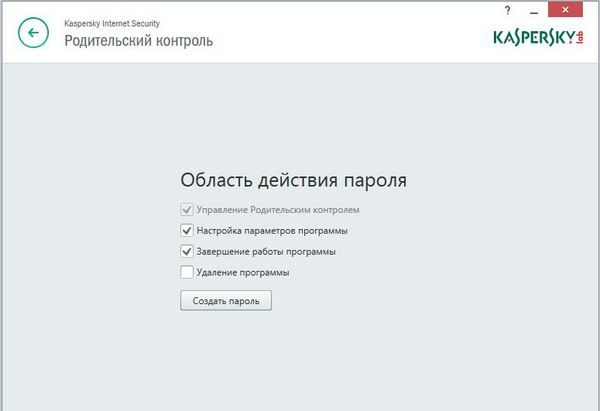
Here you can choose which program parameters will be protected set password. After setting the items you need, click the Create Password button.
Be sure to write down and save the password!
After entering the password, you will be taken to the main Parental Control window. Here you can turn on or disable monitoring for selected users, view report on the operation of the monitoring program, and setting constraints.
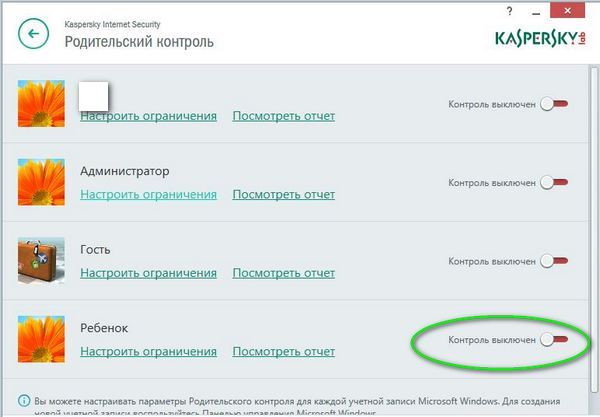
Time on the computer
After entering the settings window, you enter the time control point on the computer. Having chosen the necessary values, you can set the necessary interval of work and rest for the user.
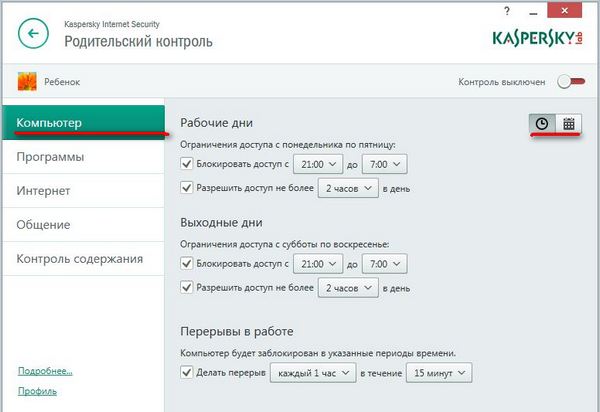
There is a possibility of different settings for weekends and weekdays. In addition, if necessary, you specify the periodical and the duration of the break.
In the same window in the bottom left corner you can click on the inscription Profile.
Profile
The settings for this window include the choice of the user profile.
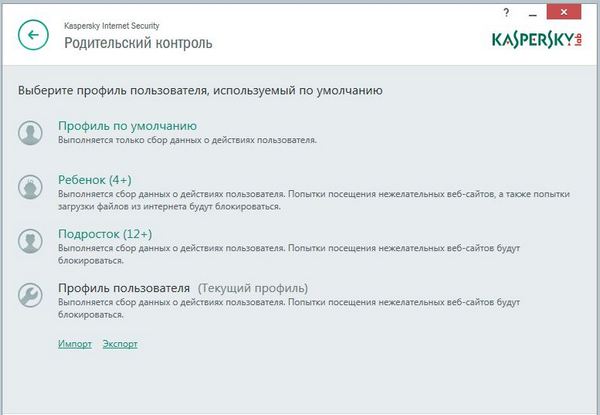
You can choose how monitoring will be performed: only in the tracking mode, age group, or collecting data about the user's work and blocking unwanted content. Clicking the arrow at the top of the window will return you to the previous program item.
Access to programs
In the "Programs" section, you can select the age limit of the programs you are launching.

In addition, you can manually select the categories of games that you consider unacceptable for the child.
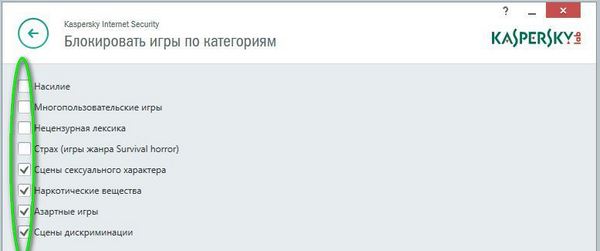
Return to the settings window by clicking the arrow in the circle.
Access to the Internet network
On this tab you can set the maximum time in the Internet for the child.
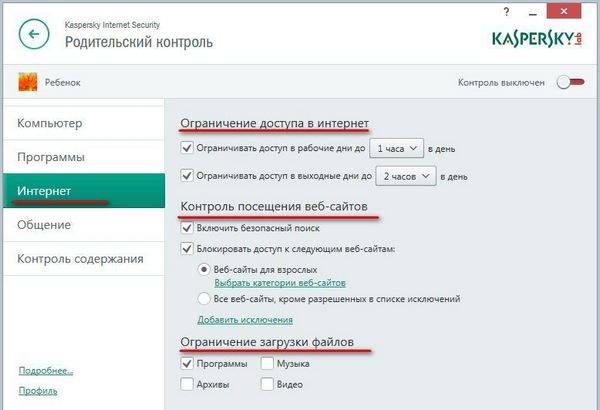
In addition, it is possible to block access to certain categories of Web sites. These categories can be edited manually, and also set exceptions.
You can limit the storage of information on certain types of computer.
Without the right of correspondence
In the next paragraph, you can set up access and the ability to track the correspondence of children.

Restrictions are set either by the principle of prohibiting certain contacts, or by allowing those who are not prohibited. There is a choice of contacts from Facebook and Twitter.
Control of personal data
In this paragraph, you control the transfer of personal data to unauthorized persons. In the editor, you can specify what can not be specifically transferred to others.
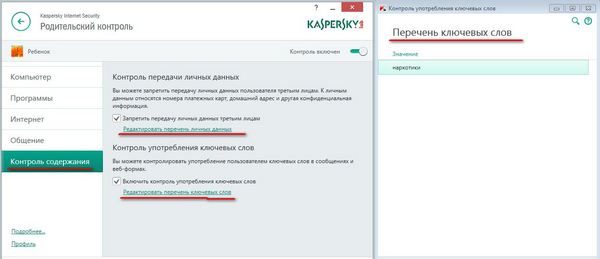
Here you can control the use of certain words in the correspondence or when searching the Internet. The list of words can be set independently.
Conclusion
But you should periodically review reports on the activities of the child on the computer and on the Internet, because any program has its drawbacks.
Apr 3 2015
Parental control Kaspersky 2015 or the protection of children from the Internet
Hello friends, today I decided to write a useful article - parental control of Kaspersky 2015 or how to protect my child from the harmful influence of the Internet.
Parental control can also be configured without anti-virus programs, for example, by means of Windows itself, but there you need to create accounts and the functionality of such control is small enough.
Configuring Parental Control from Kaspersky
Dear admin, I have one request to you, write, whatever the post about how best to save our children from the bad influence of the Internet. My son is growing (God grant health to all the kids, visitors to this site) and I want the Internet not to affect him badly! Well, you yourself understand what I mean :).
I'll show you how to configure parental controls with antivirus software Kaspersky Internet Security 2015. At the end of the article, you can see a detailed video lesson.
You can purchase its license in any computer store or on the site of Kaspersky. Here is the instruction.
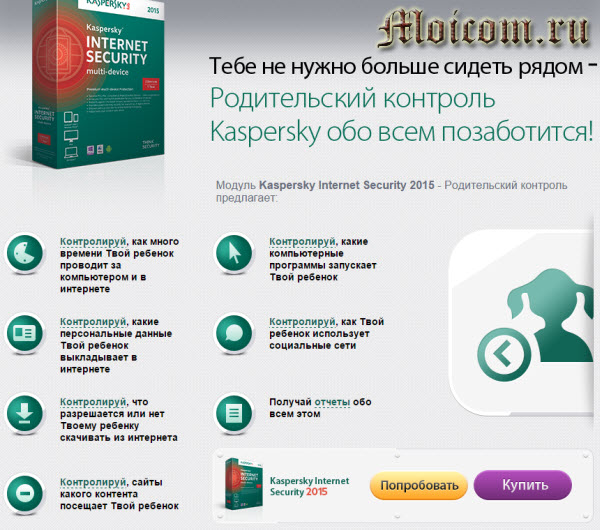
We go to the antivirus, the parent control tab.
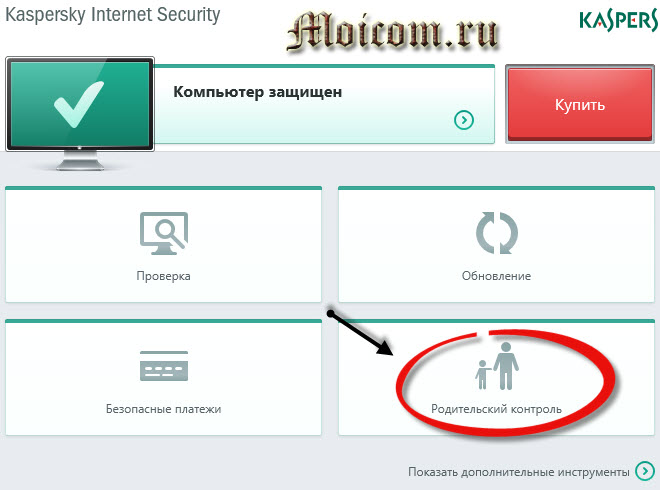
Before you start, you need to come up with a password so that controlled user accounts can not change parental controls.

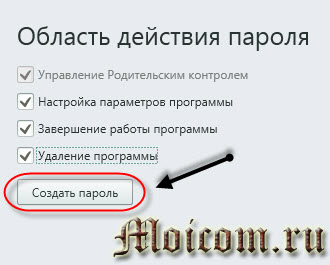
To access parental control settings and parameters, enter your code. You can check the password for this session.
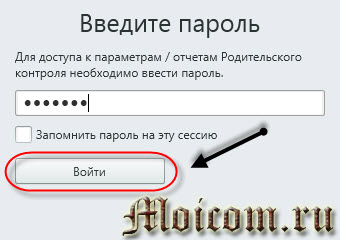
Select the desired user account, enable parental control, and go to the settings for the restrictions.
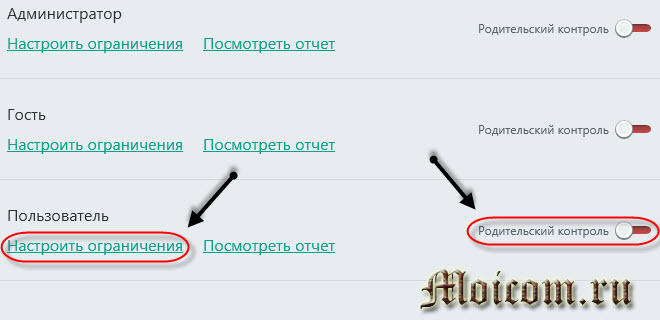
There are five tabs: computer, programs, Internet, communication and content control.
On the computer tab, you can restrict access to the PC on weekdays and weekends, as well as take breaks in work on time.

We specify in the table the hours with the prohibition and permission of access restrictions.
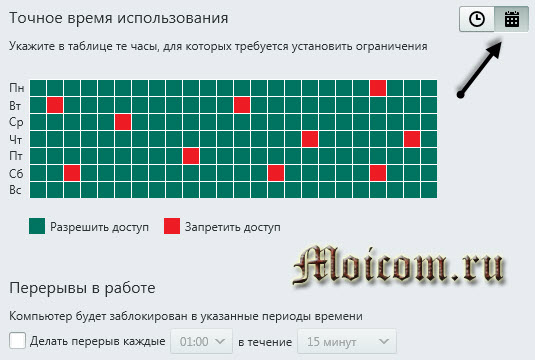
The program tab, the blocking of games by content.


Choose the blocked category of games for adults.
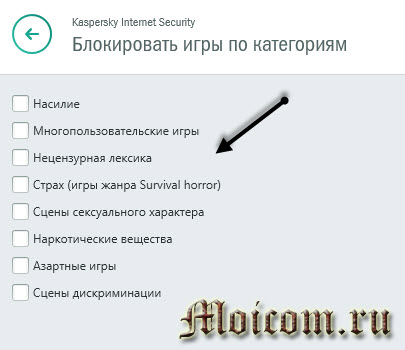
We close access to the programs: web browsers, games, download managers and torrents, messaging and voice calls, players, work with CD / DVD disks. If the program or the game is not in the list, you can add it by clicking Add program to the list.

On the Internet tab, you can restrict access to the Internet, control the visits to websites, close the download of programs, music, archives and video files.
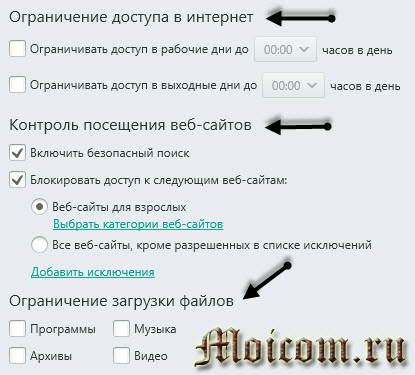
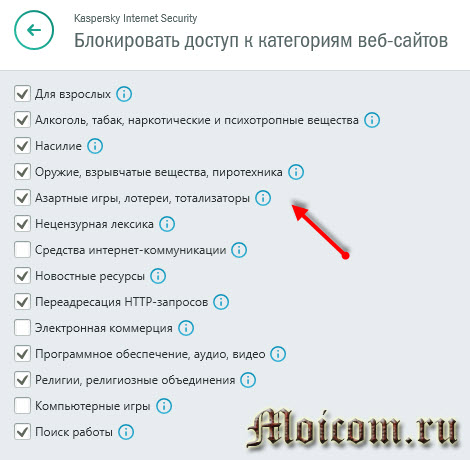
It is possible to add exceptions for certain sites both to open access and to close. To do this, go to Add exceptions.
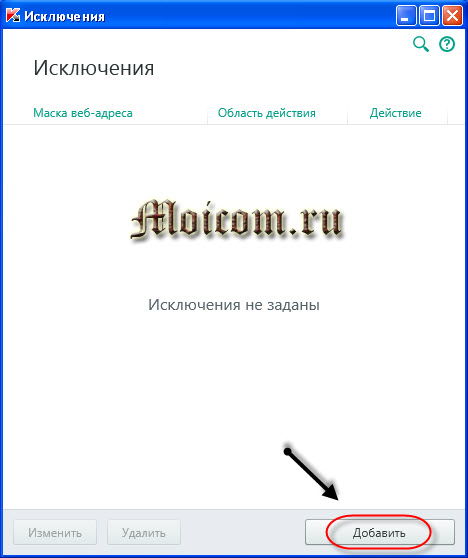
On the communication tab, monitor and limit correspondence in message exchange programs and in social networks. We allow or prohibit communication with certain contacts.

Tab control of the contents of the transfer of personal data and the use of keywords in the correspondence.
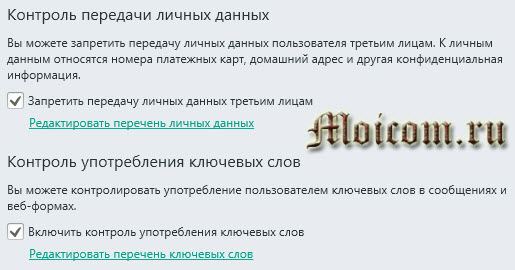
Provides the ability to prohibit the transfer of information to third parties: payment cards, addresses, telephones and other confidential data. We control the keywords in the messages.
Change Parental Control Password
Suppose your child has learned the access code from parental control or you want to change it, for greater reliability.
Again, go to the antivirus Kaspersky Internet Security 2015, in the lower left click the Settings link.

Enter the code to access the settings of the program and click continue.
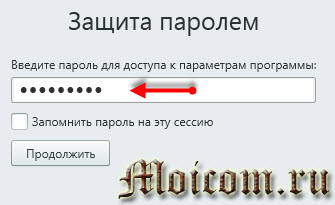

There is a password protection, enter the current code.
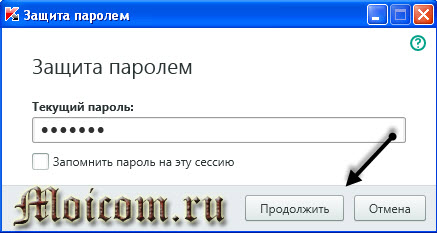
Choose the scope of the password and go to change or delete the password.
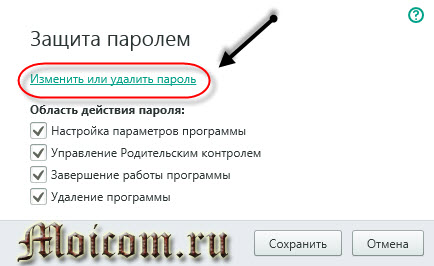
We type new password and its confirmation. If you want to remove the code, leave the fields blank.
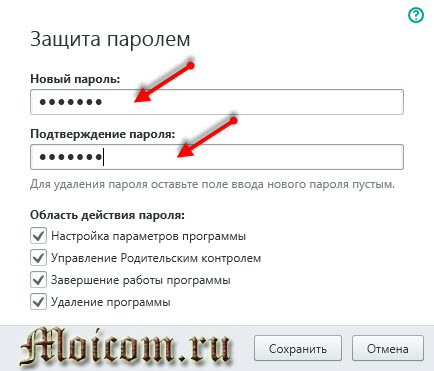
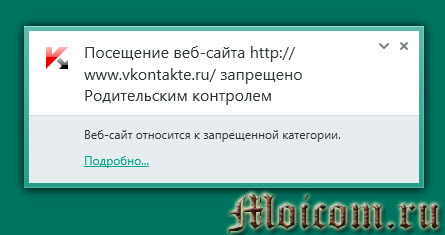
This is what parental control looks like in action when visiting closed pages in the Internet.
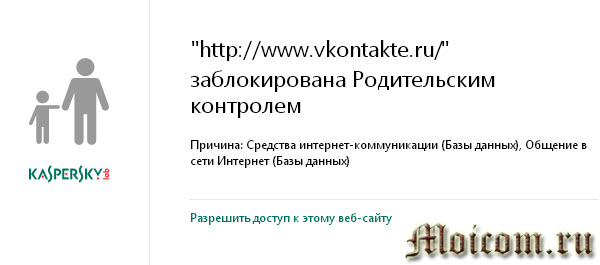
Parental Controls Kaspersky | 2015 | site
Let's sum up the results
Today we wali set up the parental control of Kaspersky 2015 and protected the child from the harmful influence of the Internet.
Perhaps you have questions related to parental control. You can ask them below in the comments to this article, and also use the form with me.
Also, you can ask any questions related to computer topics on the page.
Thank you for reading me at
Hi everybody! This article is about Kaspersky Anti-Virus!! The number of characters in the article is more than 30 000. Here is the complete manual on antivirus, read, study, study and learn a lot about what you did not know about Kaspersky! All about other articles about him, forget it. Here is all you need! Go!
From this article you will learn:
1. What is Kaspersky Anti-Virus and what is it for?
2. The capabilities of Kaspersky Anti-Virus (its advantages and disadvantages over other antiviruses).
3. How to install Anti-Virus (get a trial version for 30 days).
4. How to obtain full version.
5. Why is it better to use licensing, rather than a compromised version or left keys?
6. How to configure the antivirus.
7. Parental control of Kaspersky Internet Security. How to properly configure and use?
Protection of information: personal photos and video libraries, contact and financial data stored on your computer - what could be more important? It would seem that this is the first thing that should be paid attention to ordinary user PC.
But in fact, unfortunately, most users either do not deal with this issue at all, or do it with some degree of neglect, which can lead to disastrous consequences.
What is this scorn? In most cases this is:
Hasty choice antivirus software, most often free, and even worse than the hacked version of the paid counterpart.
Lack of due attention to the settings of the antivirus (they say, installed, and there let it protect)
These are the two most common mistakes of inexperienced users and if using officially free antivirus is not so scary (since now in the segment free antiviruses there are worthy options that can provide basic protection no worse than paid ones), then the remaining two (hacked version and poor configuration) are simply unacceptable.
But what exactly they can lead to, I propose to consider already on a concrete example a little later, and for this we need to first choose a suitable antivirus, than we do.
Which antivirus should I choose?
So we came to the question: "What kind of antivirus is better to choose?" And answering it, I will say that it's better to take a paid antivirus after all, and this concerns even those antiviruses that position themselves as free (most often there is a paid, so-called, extended version). Why?
Yes, all because the enhanced versions are called "internet security", ie they are designed to actively protect the computer during the action on the network.
Yes, most often free versions of antiviruses protect the computer in real time, but this does not concern the network, they do not have such a component, for example, as a "firewall", "safe payments" and other modules that help to ensure security on the network, and not only pure PC protection.
So what happens? If it is better to use all the same commercial versions of "free" antiviruses, then maybe you should pay attention to companies that provide only paid products.
Have authority in the market (for proof you can click on this link: here are the results independent tests)
Offer comprehensive protection of your data (including password protection and payment transactions)
Indeed, users have recognition in the CIS countries, which we can observe on the schedule of using Anti-Virus software (as of 2010):

In addition, Kaspersky Anti-Virus takes a considerable share and a similar segment, but already on a global scale:
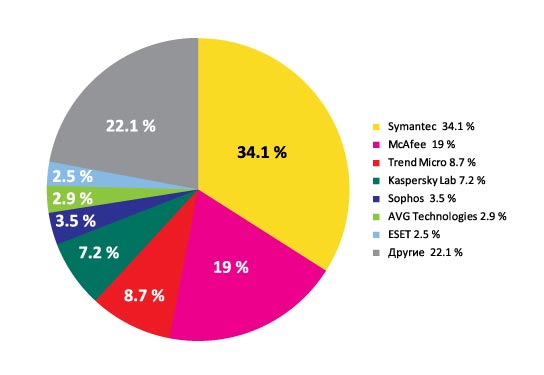
Choose the appropriate version of Kaspersky Anti-Virus
If the arguments given above seemed convincing to you, and you decided to use Kaspersky Anti-Virus, then you will have to choose the version of the product.
Since the Kaspersky Anti-Virus Lab is specialized in the development of antivirus software, it has several products for different needs. So basically all companies in this sphere have at least 2 versions:
- for business
- for home
But the whole point is that Kaspersky did not stop there and besides the aforementioned classification (which by the way is slightly different and is divided as follows):
- For home
- For small business
- For business
Also here is the next classification on the platform, so the versions are available:
1. for PC on Windows
2. devices running Android OS
3. for Mac.
But just choosing the right version for the kind of activity and platform is not enough. The thing is that for each "kind of activity" there are several products that differ in functional content.
So, for example, in the section for the house (versions for PC) there are 3 full solutions and 1 supplement. Specifically, you are offered a choice of the following products:
- Kaspersky Anti-Virus (so to speak, the basic level of protection)
- Kaspersky Internet Security
- Kaspersky Anti-Virus Crystal
And addition kaspersky password manager (intended for convenient and safe work with passwords).
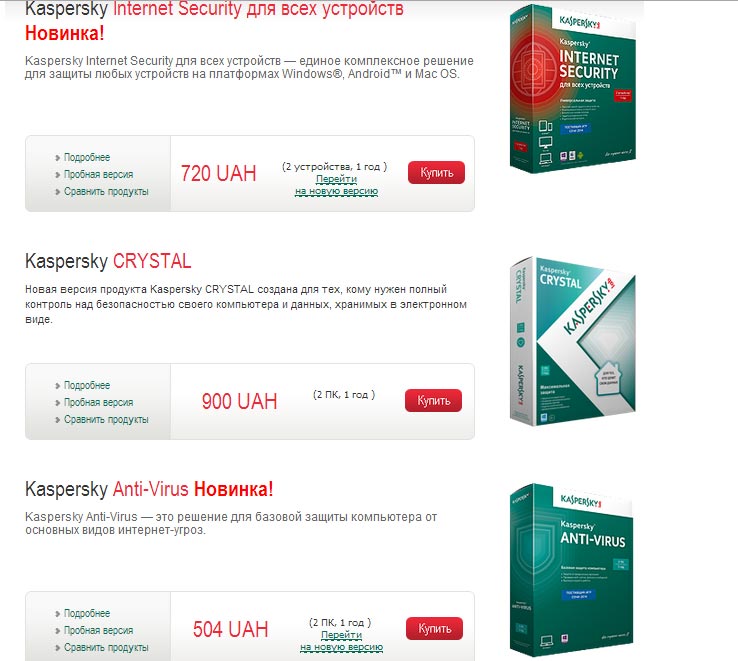
What is the difference between these versions can be viewed by going to this link, in brief, then:
- the version of internet security has, in comparison with the base, added modules that provide safe operation in the network (including financial)
- in srystal we also add interesting and at the same time useful "chips" helping to provide an even higher level of security (for example, there already includes the module for storing passwords mentioned above, the possibility reserve copy, encryption, various utilities for better cleaning the computer, etc.) in more detail on the link above.
Which of these choices? Decide, of course, to you! My advice is not to be limited to the basic level of protection ( Kaspersky Anti-Virus), and take a version of the program that more than effectively will ensure your safe movement on such an interesting, but equally dangerous Internet (Internet security)!
If the funds allow you can take and the version of Crystal - I used it, in fact, she instilled in me a love for the products of this company, leaving behind a pleasant experience, and most importantly a "clean" computer!
If you can not decide - use the trial version and test the product you are interested in. But we will talk about how to install and configure it a little later, and now I would like to voice a few tips that you need to know before installing this program on your computer.
What do I need to know before installing?
Firstly, no matter how trite it may sound, but you need to pay attention to the system requirements (generally it should be done before installing any software), but there were cases when it was neglected.
Yes, nothing fatal did not lead to this, but just to make uncomfortable work at the computer - it could. That's why I strongly recommend that you read the requirements and think about it, but will your computer "pull"?
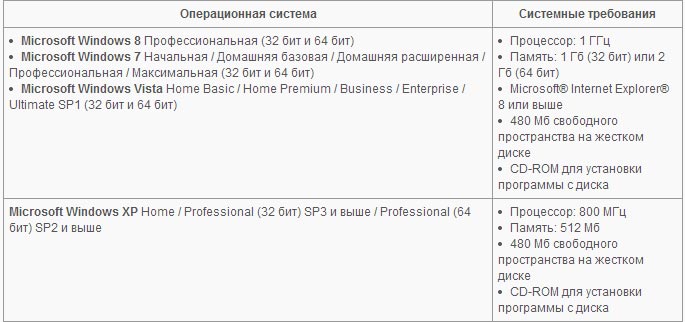
Pay special attention to the item "Memory" and think about whether you have enough "RAM" for a full job, and eats it Kaspersky is not bad (yes you can say that any antivirus loads your random access memory - but this is a special case).
Well, firstly, without departing from system requirements remember the "operative" if it eats one antivirus - this is one thing, and when they are 2 or God forbid you can not work more, the computer will "lag", "hang" and terribly "buggy", but this is the floor of trouble !!
How do beginners think? Since I have two antiviruses, it means my computer is twice as secure! No matter how it is! Antiviruses will interfere with each other's quality work, moreover, they will identify each other as a virus (Trojan program).
And this is not due to the fact that some antivirus is so bad and does not tolerate competitors, but because, by the principle of its action, it really is a kind of virus, the same Trojan, only with the opposite effect.
So, figured out the antivirus should be one. But then immediately it should be noted that the antivirus is really one, but it's also not necessary to forget about special utilities - they will not harm (of course 10 of them should not be installed, too - 1-2), the fact is that there is still malware not being viruses, but harming your computer.
For example, Kaspersky Lab also has the utility avz (designed to remove trojans, SpuWare, AdWare modules) to which antivirus programs do not survive.
So, well, before starting the installation, you should also talk about the licensing of the program. It so happened that in the CIS countries licensed software is not in fashion, to put it mildly, especially if it is intended for home use, remember how many you have officially bought programs, starting with windows?
Yes, it's not surprising what to say if hackers catch our valiant MVS using pirated copies of Windows?
But it's better not to do anything with Kaspersky, not because it's criminally punishable (if truth be told, it's unlikely) or, for example, it's not ethical, than there's no one scared, but simply because you will not get it.
You can find the keys (code), you can download the crack, and really the program will work, but there are a couple of notes.
First, imagine how the program will be hacked through the crack, as it means that it was specifically digging itself in terms of self-protection (which by the way Kaspersky works well - not once has this antivirus not only "mucks" not turned me off), and already only because this program will not be complete.
Now, let's talk in the case of the key, - yes, you will get a working anti-virus again, but for how long? - this is a question!
Do not forget that the antivirus, unlike the usual programs, often turns to the servers of its developer for updating the databases (at least once a day), where one day the "legality" of obtaining the key of this version of the anti-virus program can be verified.
And if in the case, for example, with the 2008 version, you were simply "asked" for a message that your key is blacklisted and is no longer valid (and this window appeared every 5 minutes on top of all programs), but now everything is simpler.
If you suspect a hacking, you simply block access to updates. Ie the antivirus itself works, but when trying to update the virus databases it "hangs" somewhere when it reaches 90% and after a while it just stops trying to load it to the end, ie in the end you get a working antivirus with the irrelevant at this time a virus base - and who needs such happiness?
Now if you read all the previous sections of the article and decided that Kaspersky Anti-Virus is exactly what you need (while choosing the appropriate version), then let's go directly to the installation.
Immediately I say I will install a trial 30-day version after which we will be offered to buy the full version - which you can do, in case you are satisfied with the full version of the program that you tested with me it will be Kaspersky Internet Security.
Installing Kaspersky Internet Security
So, in order to install this antivirus We need:
Otherwise, you will have a program in the language the region was on the site during the download (you can configure it later, but why create unnecessary problems?) And after selecting the desired program, click: "Trial version"
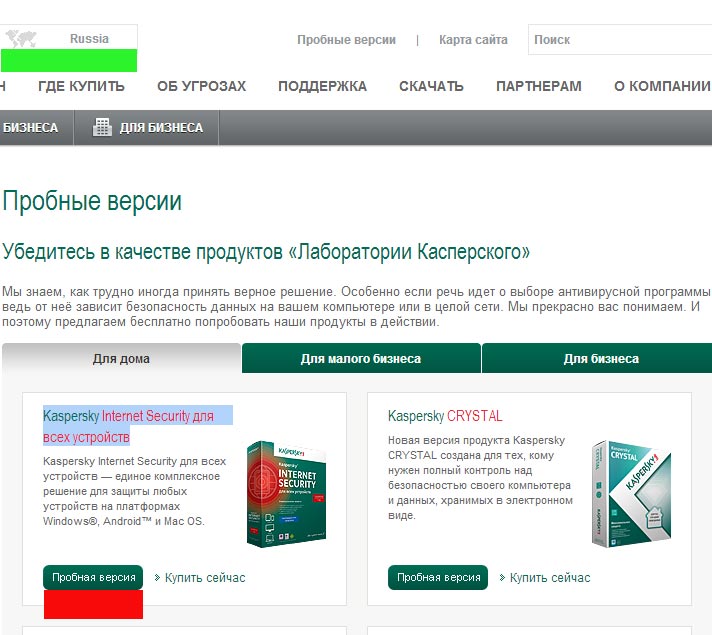
2) After that, we will transfer to the page of a specific product, where you can read its brief features, and in the case of the "Internet Security" choose for which particular platform you need a trial version of the antivirus (the fact is that Internet Security is suitable, as for Windows, and for Mac, Android and iOS).
Since I need a version for Windows, then I select the appropriate option and press "Download", after which the automatic download of the installer (installer) will begin.
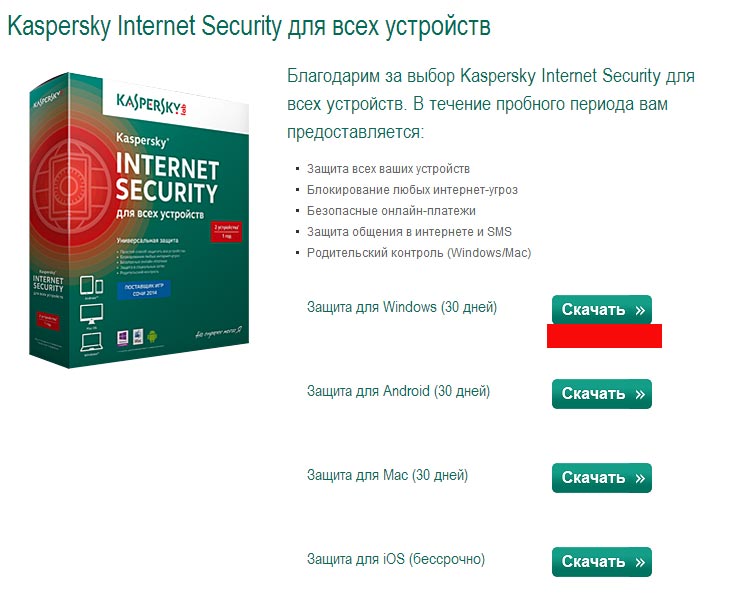
3) After the download is complete, you can start the installation itself beforehand, but I want to remind you about the need to remove your old antivirus (about the reasons mentioned above). So run the downloaded installer ...
4) Before us the welcome screen, click the "Install" button

6) After that, you directly install the program components on your computer
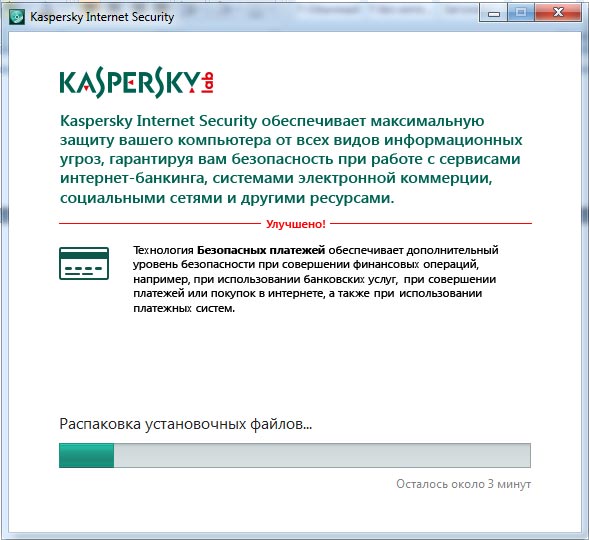
7) After the unpacking is complete, a window will appear in front of us, in which we will be thanked for choosing Kaspersky Lab products and will be offered to launch Kaspersky (in case you do not agree, uncheck - but I do not recommend it).
Press the "Finish" button and the installation will smoothly approach the final stage.
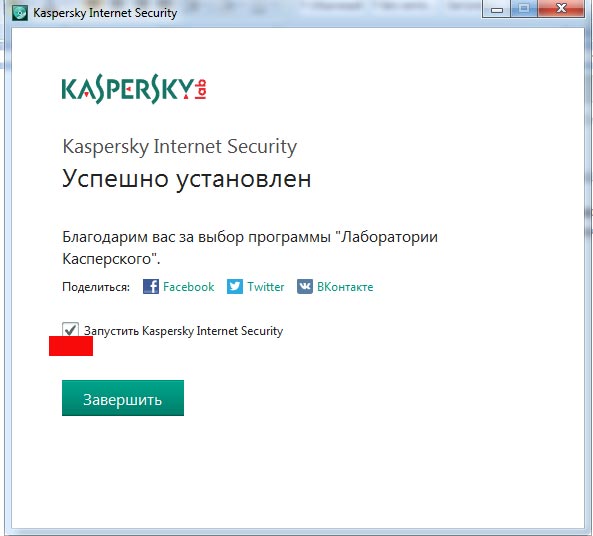
8) After starting the program - it will go to the tray (task bar) itself, and before you will appear a window offering to enter or purchase an activation key. But after all, we intended to test the product first, and then buy it - right?
Therefore click on the link "Activate the trial version of the program." By the way, this item will not be provided if you have already installed a trial version of Kaspersky Anti-Virus (yes, there are programs on the network that discard data about the use of the products of this developer before, but what does this lead us already said).
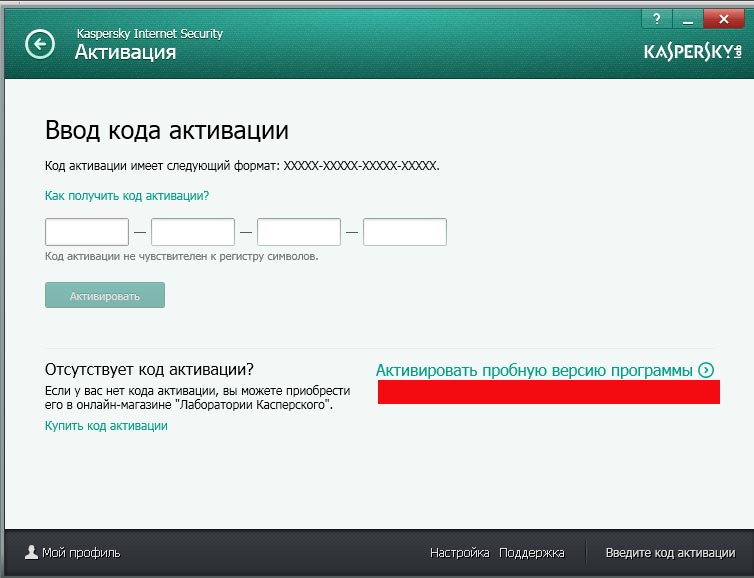
10) After the connection is established, you will be thanked for choosing Kaspersky products and will be offered to register and subscribe to company news, interesting offers and so on. I prefer to give up this step (in our time mailbox and so much littered with a bunch of useful letters from which - not much).

11) All activation is complete. Before us the last window informing us about successful activation is displayed, click on the "Finish" button, the main program window opens before us and we proceed to the next section, but beforehand I strongly recommend that you restart your computer.
Well, after rebooting the computer it is necessary to configure the antivirus for as I said earlier it is not one of those whom you can put and forget. So, let's go!
Setting up and reviewing the program
After opening the program, the main window opens in which the main computer status will be displayed, namely:
The status of the license (and the days before its expiration)
Virus Database Status
Information on the main protection modules
Number of Existing Threats
In the event that all of the above normal screen on the main panel is green, if the problems are yellow, if there are critical problems that require immediate intervention, the screen will turn red.
In addition, when you click on this screen (or the "More Details" button), you will be able to look at the existing problems at the moment - I only have a notification about a free trial version with the number of days left.

Well, now let's make the basic settings of the program, since I already said that it's impossible to let it go at all. So, go to the "setup". We fall into a new window that is divided into several subsections, according to which we will also go through. In the meantime, start with the subsection "General".
General.
Well, first of all, the green button presses on itself which will move the "dvizhochek" and disable the protection (ie the antivirus itself) - then the tray icon will turn gray, which will symbolize that the antivirus is disabled (I certainly do not recommend this) - if you want that Kaspersky would just not let you know about his activity for a while by sending notifications to the bottom of the screen - just turn on the game mode, but before that we'll get, and now we'll continue to review the "general" tab.
Here we have a subsection "Interactive Protection" and "Autoplay" - I advise you to leave all 3 tick marks. The first two, which would effectively protect your computer, but at the same time not to remove any important component (that's what "Quarantine" is - we'll also talk).
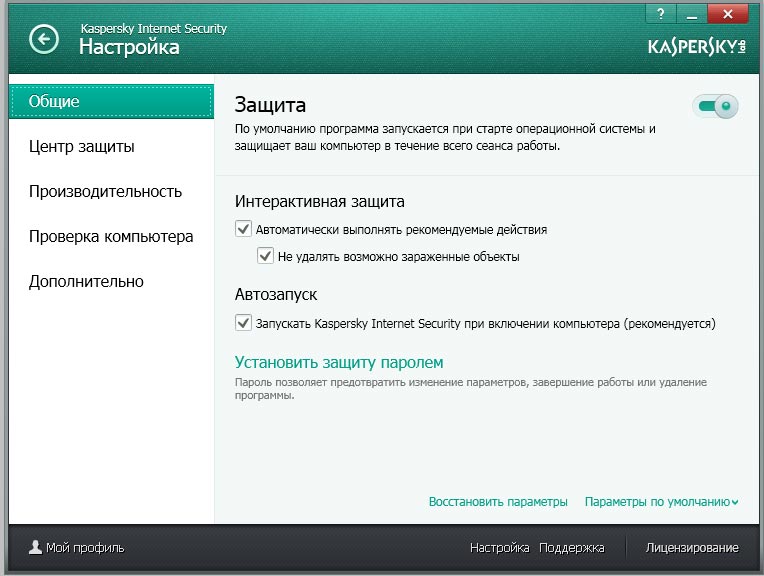
Well, before moving on to the next tab, I'll draw your attention to such a point "Set password protection" - this sets the password for the program, not the user, and will prompt it for important program actions (by default, if you enable this item: when attempt to turn off the program and change settings settings).
But now I will not put it when we get to the "Parental Control" - this topic will "come up" yet, but for now we are moving on.
Protection Center
Here you can enable / disable protection modules, and when you click on the name, configure the protection level. By default, all components except Anti-Banner are included.
Why is Anti-Banner disabled? - I suspect in connection with the unstable work in the previous versions programs (this module blocked access to many popular Internet resources due to the presence there "aggressive in the opinion of Kaspersky" advertising.
Therefore, if you include it, then go to its parameters and read the sub-paragraphs "use the list of prohibited / permitted web addresses", and if it is specific, then the sub-item "configure lists ..." - but I do not advise you to include this item. Better to block banners and advertisements, however, use third-party plug-ins (the same adBlock).
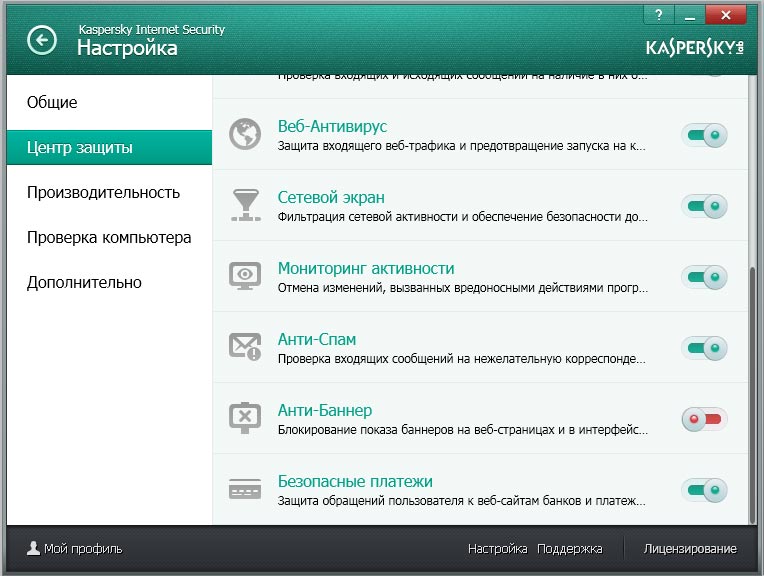
In general, you can walk around the points of this menu and set up a "Security level" - (well, for example, if you work through a public wi-fi network - it is better to put a high level of Web antivirus and services responsible for network protection).
If you work through home network, then leave the recommended - this will save the computer resources and provide normal protection.
Performance
This is a very important point, especially for laptop owners and weak PCs. And the first point we are greeted by "Game Mode" - this tick should be set when you play or just for some reason do not want to receive program notifications for a while. Agree quite conveniently, most importantly do not forget to tick off after completing your affairs.
Next is the checkbox "Reset resources to the OP when the PC is booted" - by default the check mark is selected, I removed it, since security is especially at the start of the system when is running all programs (including malware if there are any) - goes at the start, so I would prefer that the antivirus was launched one of the first not yielding to none.
The same is true for the flag "assign resources to other programs", which is removed by default (if it is delivered, if the CPU is heavily loaded, the antivirus will sacrifice "its own interests" such as virus scanning and execution of planned actions - we leave it off.
The remaining two checkmarks are left in place. Ie "Perform the check during idle time" - you can read the description of this function under the check mark (in brief - if for a certain period of time there is no activity of the user, then the antivirus will start an active scan of the computer) and the checkbox "Search for rootkits". Here's what I got:

Checking your computer
Here we are asked to set the security level (I repeat: I left it on the recommended one - as it is quite enough, and I work through the home wi-fi network).
Next, it is suggested to choose the action when a threat is detected (I set "to inform" - in order to select the action myself, that the program would not unintentionally uninstall some "cracker" from the archive), and checking removable disks - "request an action" for a split second to decide on scanning a removable disk than to wait for the end of its verification, if I'm sure of its cleanliness).
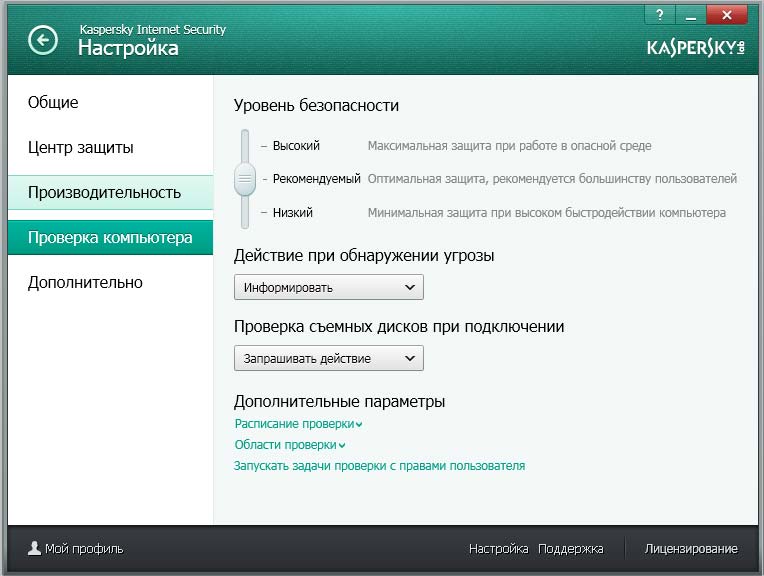
Additionally
On this section, I will run quickly and only on its main parts. So let's go:
Update - here you can set where and how often the program will download virus database updates.
Well, I immediately say the source of the update - you should not change it, and you should put the updates in the mode "Automatically" - so that it downloads updates when it considers it necessary, or you can put "Request permission to install" - if you merge for the amount of traffic. Set the same mode "Do not download" - I do not recommend it!
Safe data entry - here you can configure the parameters of the virtual keyboard (which we'll get to before, but we'll look at it in passing) - for example, you can put a combination of keys on a call (though only suggested by default), put protection on data input from the hardware " and set up the quick input icon
Further the item "Parameters of Threats and Exceptions", here you can configure the programs that "Casper" will not touch, in addition I advise you to go and check the item "Discover other programs that can be used for harm", below you can read what it is.
If you intend to use such a program, for example TeameViewer - just add it to the excluded ones.
The item "Compatibility" is also left as is.
"Network" - here I propose to go and in the item "Controlled ports" put the radio button on "Monitor all network ports", and not only the selected ones. The point "Checking secure connections" is left as is. And pay attention to the point of the proxy server that should be logged in and indicate if you use it to connect to the Internet.
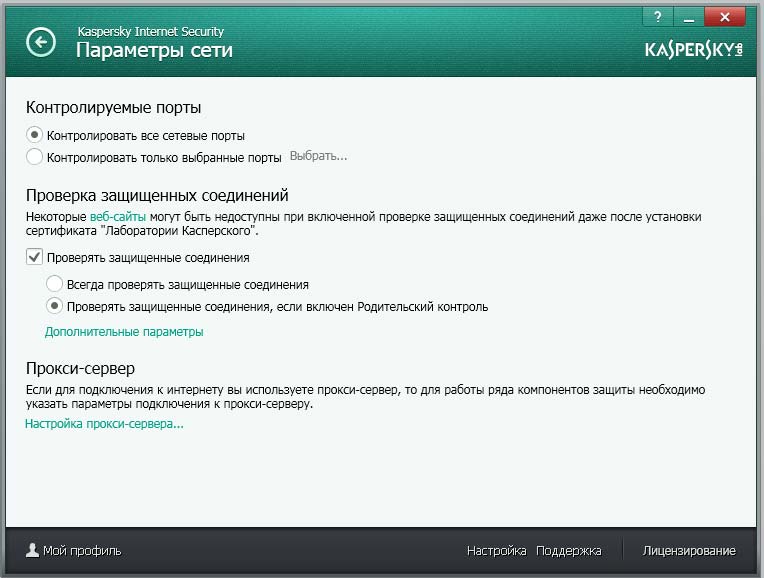
In the notification tab - you can configure which notifications about the program's operation will come, which ones do not - here I will not stop.
"Reports and Quarantine" - here you can set the time, how many reports will be stored, limit their weight, enable / disable recording in reports of non-critical events, and specify how many files to keep in quarantine and limit their size (I have enough space and settings here it suits me - I leave it as it is, you see it yourself).
Feedback - speaks for itself
View: here you can select a language and enable the animation of the icon in the tray (for example, when updating)
On this with the settings everything! Now I would like to go over the main points of the main menu (not all). Let's start:
1) Checking . In principle, it speaks for itself - this is what the antivirus was for. There are several types of checks (full - the entire computer is checked, the fast one is important areas, that is basically the C drive, selective - checking separately specified folders and objects if the user has doubts, well, checking removable media - ie flash drives, "pockets" "- or removable hard disks in other words, etc).
And before I leave this section I would like to remind you that it is not worthwhile to "hammer" the check, moreover, I would recommend that you go through the link "parameters and schedule"
We will throw in the already familiar window in which we were during the settings and go further on the link "Schedule of checks" select the item "Full scan" and put the item to run the check: to "weekly".
Next, choose the day of the week when you usually do not happen at home (would advise either Monday before lunch, because most at this time they work and they do not need a computer - just do not forget to run it and go on business, or the day off when you usually walk or go on business, but at least once a week, such a check should be done. "Here's how I did it:
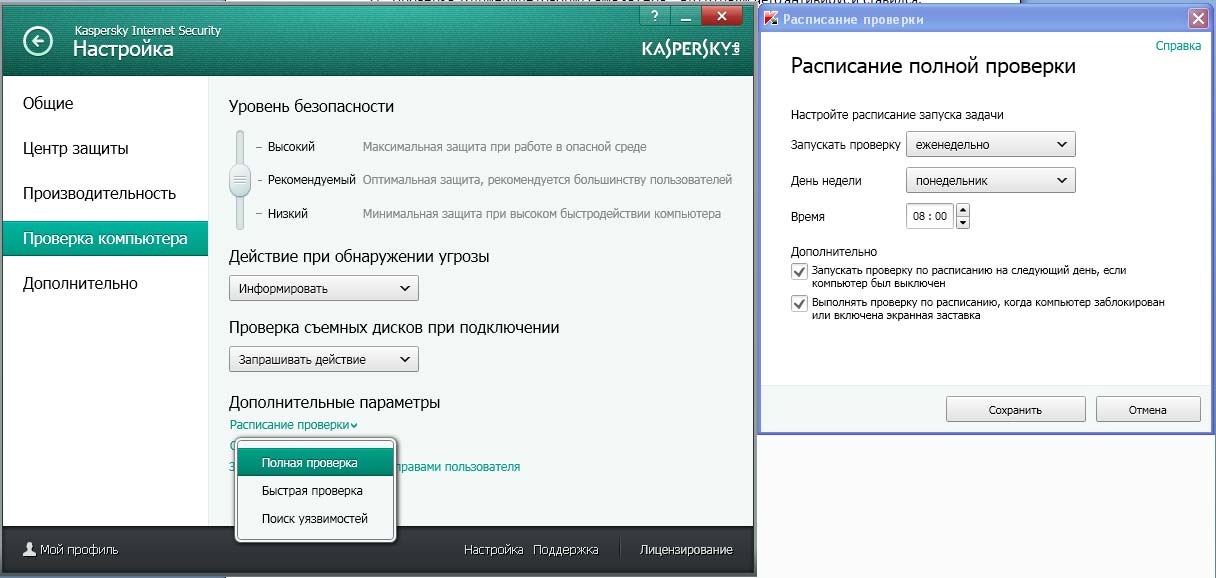
2) Menu item "Update" - from here, firstly you can get to the same settings menu as often and where to ship updates, and secondly, if you want, update the database by clicking on the corresponding button.
3) By the point "Secure payments" - I personally did not use it, according to the information from the knowledge base of Kaspersky, this "miracle" works as follows: when entering the site, it positions itself as a payment system and checks certificates, the authenticity of the address (ie, it really belongs to the payment system, and is not phishing for example) - by comparing the received address with its payment systems and banks' database, it checks your OS's readiness to work with the financial operations (that is, there are no threats like Trojans and other wickedness).
4) In paragraph "Reports" you can get acquainted with various accounting information about the program: threats found, databases, checks on their results, etc. both in general and for a specific period.
5) Network Monitoring : here you can find information about active network connections, the number of incoming and outgoing traffic at the moment from running programs (including browsers), the number of open ports and computers from which attacks were made (if any).
In addition, from here you can disable any network activity if there is such a need.
6) Quarantine : here you can see what files are currently in quarantine (the file is moved to quarantine if the treatment was applied: ie you had an infected file N, the antivirus cured it - in fact replacing the infected file - healthy, but if you suddenly need to return infected version of the file (you can hardly need that version - there are different situations) - then you can restore it from quarantine, I hope it is available.
7) Instruments - here you can use various utilities built into Kaspersky, I also do not use this section - preferring third-party programs, but if you are interested, you can "climb" there (for example, you can use such tools as OS recovery after a virus attack, after infection, cleaning traces of activity, setting up browser settings, creating emergency disks).
8) Control of programs : here you can see the number of programs in groups (trusted, restricted, not trusted), and also clicking on the "Program Management" button to look at which specific groups belong to, allow or forbid their launch, and when clicking a certain program, configure it rights in the OS, when working on the network, specify whether or not to check the files working with this program, etc.
A range of options and options for setting what you can, and what is not - is simply huge. This is how the window looks (but I only advise you to dig and change something if you clearly understand that after your "tyke" should change):
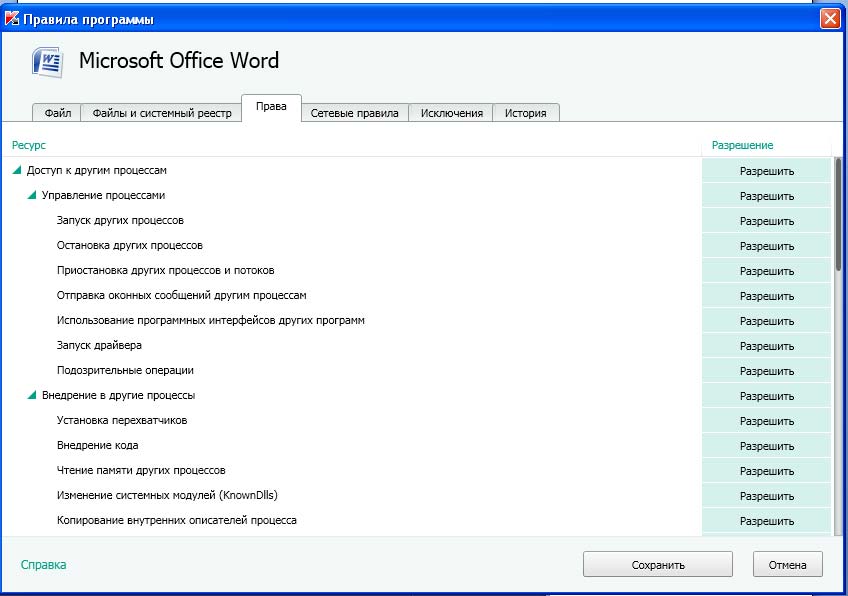
9) Virtual keyboard - serves for secure data entry on important web resources (payment systems, etc.), that is its main purpose from interceptor programs that can read data while they are being "fetched" from a fixed keyboard using spyware.
But on the very site of Casper warn that in case of hacking the site on which you enter data - the virtual keyboard will not help you. Ie it protects purely from interceptors.
Parental control
Well, we looked at almost all the menu items, but there was one more. A pleasant surprise for parents who want to control what their child is doing while sitting at the computer and what exactly he / she is doing. We are talking about the so-called "Parental Control"
So in order to start work with him we go in the menu of Kaspersky and press "Parental Control"
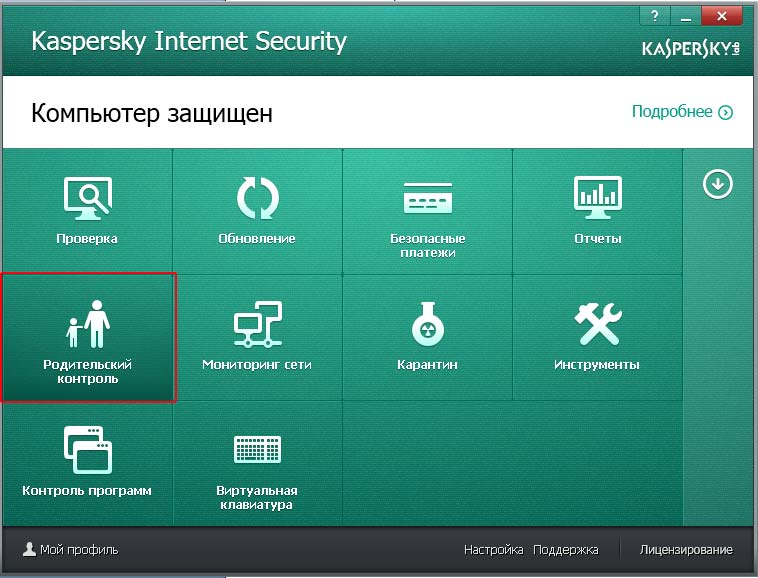
We will open a password protection window (which the child could not remove), where we will have to come up and enter the password 2 times (if you remember a little earlier, we already encountered a password - it's the same, there is one of the items for which you need its input was precisely parental control). So, we introduced and continue:

In the next window you will be asked to select the scope of this password (to control the parental control in this case, it is set by default). I'll leave it as it is and I will not put a check mark on the removal of the program, I will leave this way for a retreat in case I forget the password (although this does not happen to me, nevertheless).
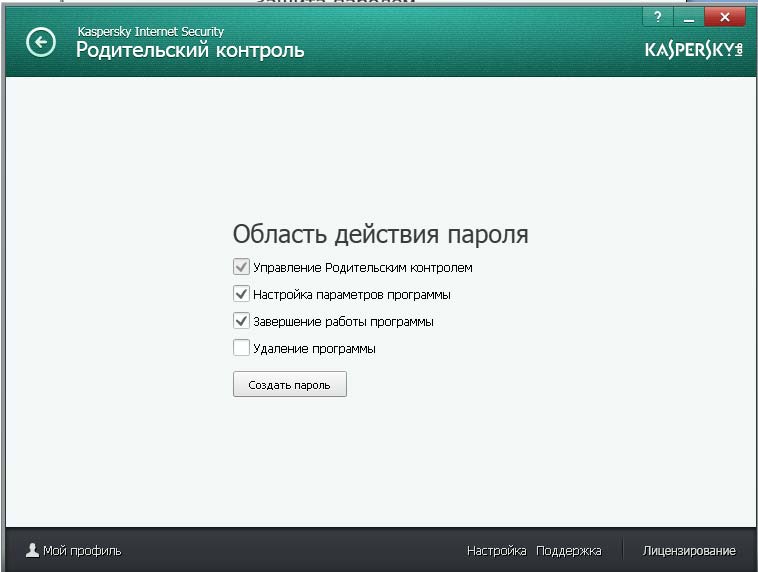
After clicking on the button to create a password, we will be redirected to the following window, where we can set which users to enable parental control. I'll include for an example it for the current user "Sergey" in order to show you some interesting functions and settings.

To continue click on the user for whom you want to configure the parental control. The following screen appears before us:
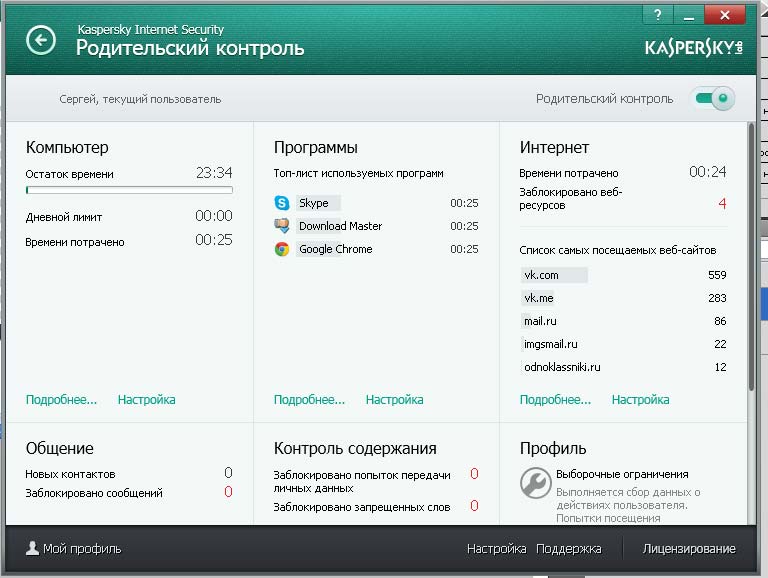
Ie here we can see how much time the child has spent from the allocated to him, the main programs that he used during this period, how long he stayed on the Internet, how many new contacts were in instant messengers (such as ICQ and Skype), how many times he tried to transfer his data 3 persons, and also we can set up a profile (there is a schedule for what age and what it means), I suggest that you leave it on the profile that is and better to configure it yourself. To do this, click in any of the three green points "tuning"

We get to the following menu:

(I pre-configured) - as you can see everything is broken into 3 blocks.
I did the following: put the computer lock on this user at the time of sleep (I have it from 10 pm to 8 am on weekdays and from 9 pm to 8 am on weekends), in addition, you can restrict access throughout the day, for example up to 2 hours - this means that a person entered under this user on the expiration of 2 hours allocated to him can not work anymore, in addition, there is the possibility to put forced rest for example on the screen is set so that every hour of work the user rest 15 minutes.
Approximately 5 minutes, for example, before the break, a sign will appear on the screen that will warn you that you have to work so much time.
Let's move on to the "program" point.
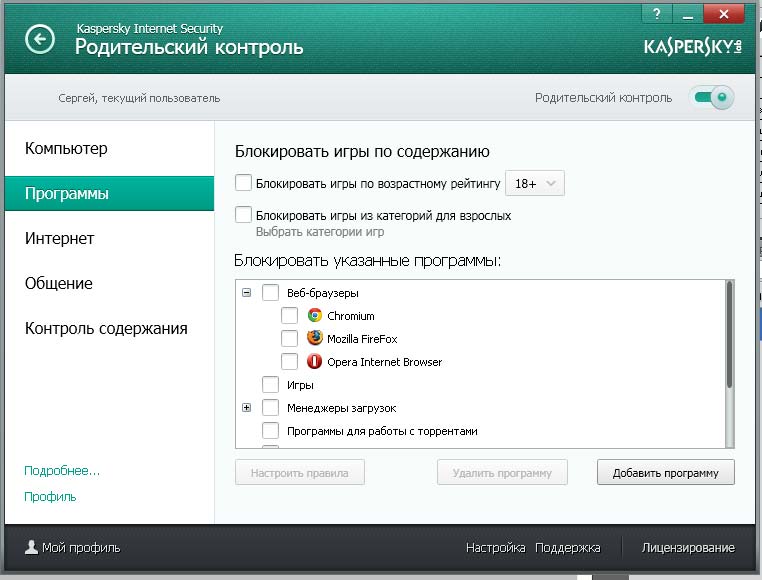
Here you can:
Blocking games by age (to choose 18, 16, 12 7 3) all probably saw restrictions on the boxes with games and wondered: "But who will stop it?" - Children may not, but the parental control of such a toy will stop.
In addition, you can block games for adults (and in addition specify specific categories: that is, there are scenes of violence, or gambling, games with prices of discrimination, etc.)
Also you can block whole groups of programs, for example "Web browsers", and specific programs, for example: Opera. In addition, you can select a specific program by clicking the "Configure rules" button, where you can restrict access to a certain program to so many hours on weekdays / weekends.
And also to set breaks (everything is similar to a similar case earlier, so I think that you do not need the screenshot).
Internet: here you can also set a restriction on the number of hours spent on the Internet on weekdays and weekends (for example, on the screen below at weekends, the user can sit on the Internet for 4 hours).
Also here you can enable secure search (ie it is not in the case of introducing a bad word into the search engine: for example, "sex" - he will not have anything to give, for example in Yandex there will be a page "Unfortunately there was nothing to be found." Later, when you enter a bileberd).
Also you can block access to certain groups of websites (categories are configured by the corresponding link underlined with a red marker on the screen). And finally, you can put a restriction on downloading files (video, music, archives, programs or all together as a screenshot):
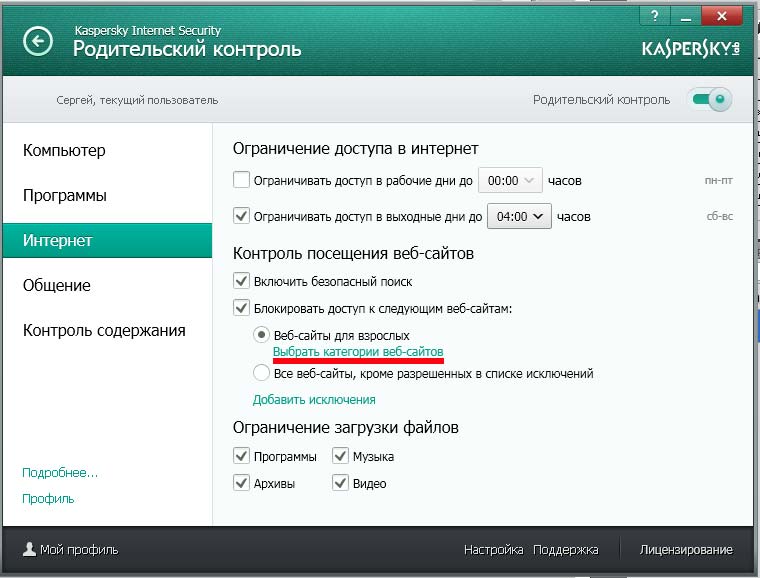
In the point of communication you have only 2 mutually exclusive options:
- allow communication with all contacts except forbidden;
- prohibit communication with all contacts except those permitted.
Just do not forget to set up the appropriate lists.
In the content control point you can:
- control the use of keywords, the list of which you ask yourself
- prohibit the transfer of personal data (ie if the user entered a home address in ICQ that would be sent to someone - it will not work for him.
Well, that's basically all I wanted to tell you. It turned out quite the same volume, but if there are questions - ask in the comments. On the last, I will give the following advice: let the program stand for a month, if you like it - buy a license, if - no, then ... Ie, observe, get used and draw a conclusion.
Here's how to buy a license:
In the products of Kaspersky Lab for many years there is a module of parental control. Last year, developments in protecting children on the Internet resulted in the creation of a separate Safe Kids product.
We are often asked how Kaspersky Safe Kids differs from parental control in our products to protect home users. Partly, of course, their functionality is the same, but there are a number of fundamental differences.
Multiplatform
According to polls conducted by Kaspersky Lab among Moscow schoolchildren, 80% of families that use programs for children's safety on the Internet install these programs on only one device. Most often on a computer. Children's smartphones are protected by parents in about 10% of families. However, at the same time, about 70% of schoolchildren use more than one device to access the Internet, and 80% of respondents consider the smartphone to be the main means of web surfing. In the regions mobile Internet yet not so common, but its implementation is very active, so we expect a similar picture across Russia in the coming years.
That is why the main difference of Kaspersky Safe Kids from the component of parental control in Kaspersky Internet Security is the ability to install not only on desktop computers and laptops, but also on mobile devices of a child running under two of the most popular mobile operating systems, Android and iOS.
Flexible settings
Another difference between these two programs for ensuring child safety is the convenience of customization. The Parental Control component in Kaspersky Internet Security is configured by the parents on the child's computer. In this case, an adult needs to be directly at the computer. Safe Kids settings are made through personal Area on my.kaspersky.com. This adds flexibility to the product - for example, it allows you to adjust the restrictions, even if the parents are at work, and the child is faced with the need to add to the exceptions some site that is necessary for doing homework.
In addition, this method of managing the solution allows you to simultaneously apply uniform settings for all your child's devices.
Availability of reports
The main ideological advantage of Kaspersky Safe Kids is that it is a tool that gives parents the opportunity to understand what the child is doing on the web, what are his interests. The program allows you to build reports on the activity of the child on the Internet, sends notification of attempts to visit prohibited sites or to search for dangerous information. This, in particular, gives parents the opportunity to respond quickly to a difficult situation in the life of the child and tells what the child should be talking about first.
New Features
In addition, support for mobile devices has led to the addition of new features that were either unattainable on computers or simply not needed. Firstly, it is the ability to monitor calls and SMS, allowing you to understand who the child is communicating with. Secondly, the function of geolocation, showing where the mobile device and, accordingly, the child is at the moment (as the children practically do not part with their phones or tablets). So this allows us to ensure the safety of children not only in digital reality, but also in the physical world.
Also, Safe Kids allows parents to monitor the activity of children in popular social networks without even registering with them, via the same personal cabinet at my.kaspersky.com, where the status of the child's tape is displayed, as well as a list of his friends.
In other words, Kaspersky Safe Kids is not so much a monitoring tool as a tool to help parents raise modern children. Children belonging to a new, digital generation that does not part with gadgets day or night.
Parental control is the type of software created to help parents to control their pastime at the computer of under-age children. This type of software can be implemented as separate programs working locally or in the format of web projects with the use of modified browsers, such as the children's browser Gogul, created as part of the federal program for secure Internet. Parental control is part of the regular Windows functionality and a separate module can be included in the assembly third-party programs to protect your computer. The last variant in this article will be discussed in detail. Below we consider the function of parental control in the known assembly of the protective software for the computer - Kaspersky Internet Security.
1. Kaspersky Lab VS Microsoft: whose parental control is better?
Why use third-party software for parental control when such a tool is provided as a Windows feature? Moreover, if it is a paid software product, which is Kaspersky Internet Security. Windows has a basic Windows parental control over Kaspersky Internet Security with two main advantages: it's free and can be controlled via the Internet from any device via the web interface account Microsoft. But, first, the possibility of remote control of parental control may not all be considered a practical advantage. Secondly, staffed as a shortcut to a separate utility, like Paint or the "Calculator", can not be found. Before, it is necessary to configure family accounts on the computer, the adult should be authorized with the account microsoft records, create one for the child, connect it to the Microsoft Family system, etc. It's easy, provided that the user knows how this system works, and what step to follow. While Kaspersky Internet Security offers more flexible settings for parental control, and additional features, and ease of use. Parent control Kaspersky Lab does not need Microsoft accounts, the system of prohibitions for children will function when using regular local accounting windows Records. And directly access to the parental control function is obtained directly in the center of the Kaspersky Internet Security window.
Well, the most important advantage is that the parent control from Kaspersky Lab gets into the appendage to a powerful antivirus solution and a selection of various additional security mechanisms. The product Kaspersky Internet Security creators give free testing for 30 days.
2. The principle of parental control from Kaspersky Lab
To control a child, an adult needs to create a separate local account for him, and in his administrator account, set the access password to the Kaspersky Internet Security's parent control module. At the stage of creating a password, it is better to establish all the proposed areas of its operation. If you include items with ticked off, which provide for the completion of the program and its removal from the operating system, a child who does not know the password can not get rid of Kaspersky Internet Security.
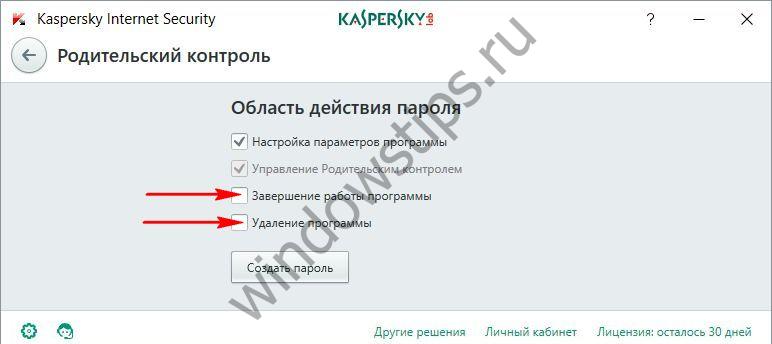
Parental control is activated for the child account by a slider. For each of the monitored accounts, the settings that limit the work with the computer and the section of the child's activity report will be available.
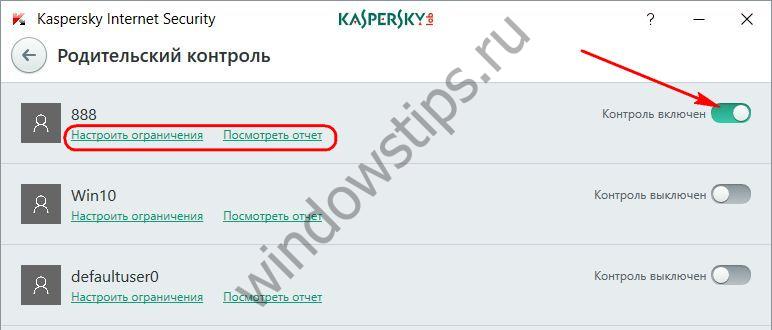
3. Parental control settings from Kaspersky Lab
Kaspersky Internet Security offers both traditional tools for monitoring the child and subtle settings, inherent not every software product for the implementation of the genitive control. From traditional possibilities:
- Blocking access to the computer on a flexible schedule;
- Adding periodic short breaks;
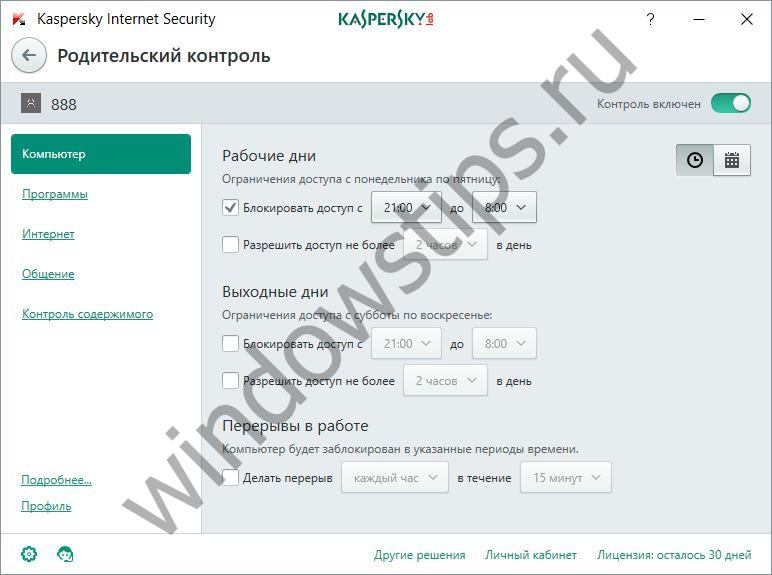
- Blocking the launch of programs and games, separately added by the user and not corresponding to the rating of the European PEGI system, which provides censorship by age of users and content content;
- Daily restriction of access to the Internet;
- Block access to unwanted sites in accordance with the Kaspersky Lab database;
- Ability to form your list of sites to which access is prohibited;
- Ability to prohibit access to all sites, except for certain permitted;
- Export-import profile settings.
Kaspersky Internet Security can offer features not found in the parental control mechanism from Microsoft and usually not provided for free software of such kind. What are these features?
In the "Internet" tab, you can configure the prohibition of downloading certain types of files to the network: program installers, archives, audio and video.
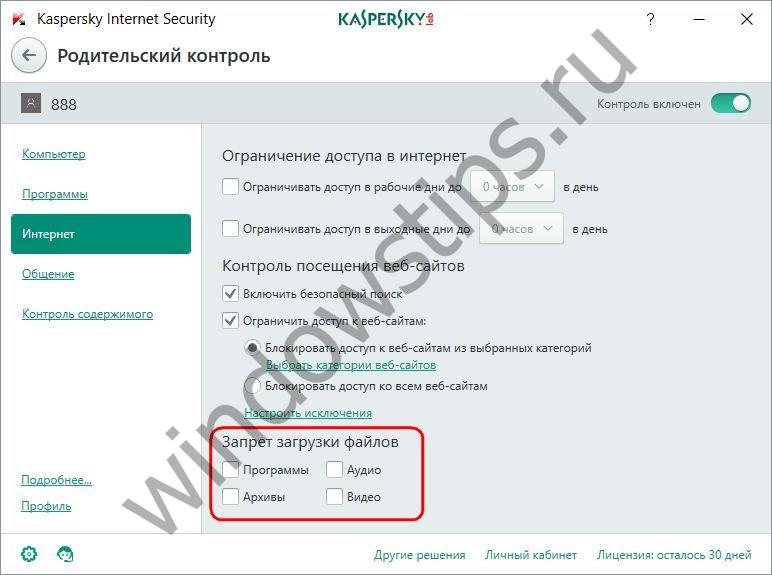
The tab "Communication" provides for blocking contacts in social networks - all, except for banned, or all, except those permitted.
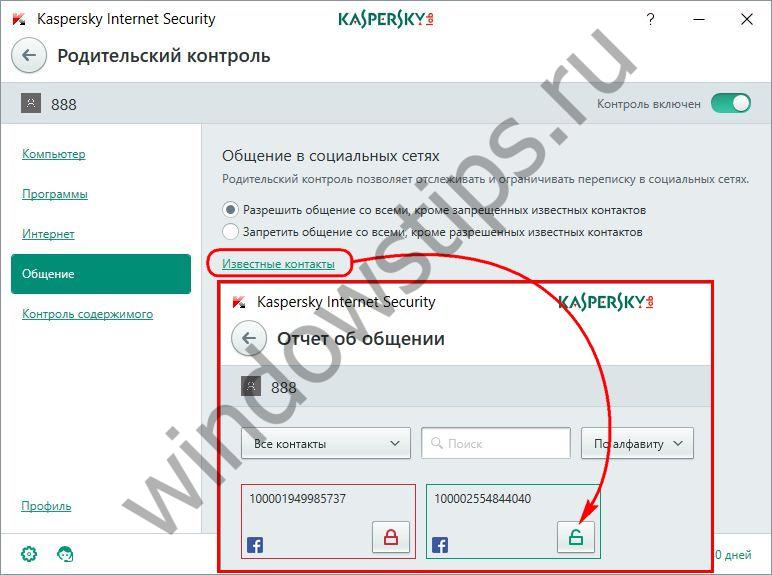
In the Content Control tab, you can configure the list of keywords entered by the child to be tracked by the parent, and, perhaps, one of the most important points is the personal data blocked by the program.
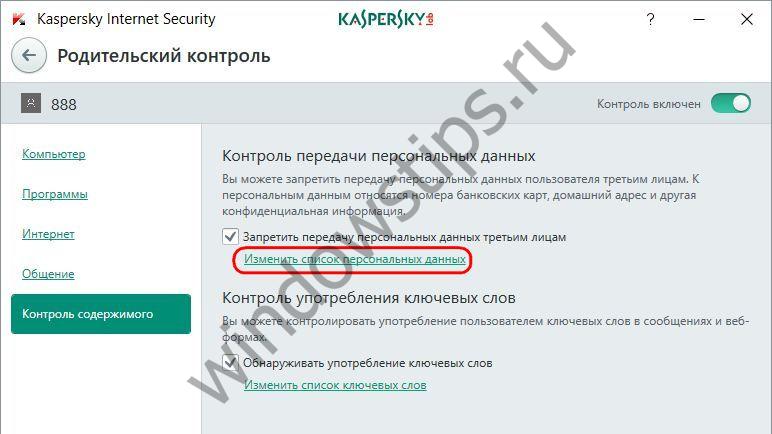
The child will not be able to transfer the numbers of payment cards, telephones, addresses and other confidential data by the parent to third parties via the Internet. When you try to send sensitive data in a browser window under a controlled account, the transfer of this data will be blocked.







